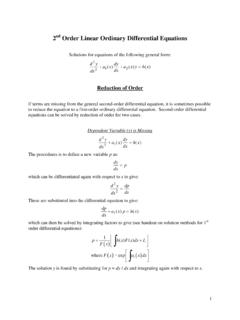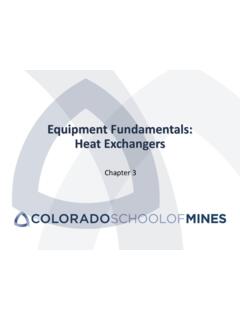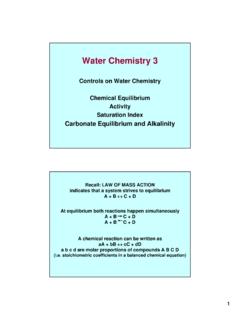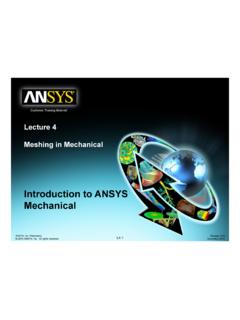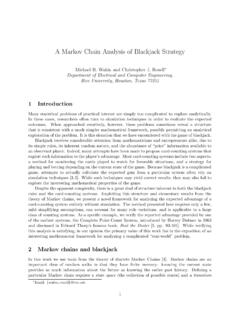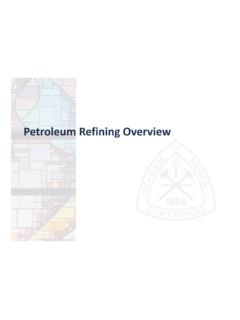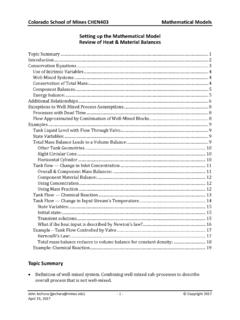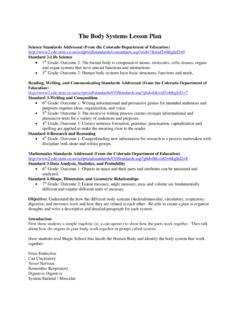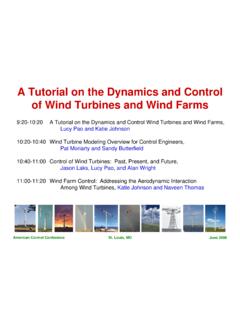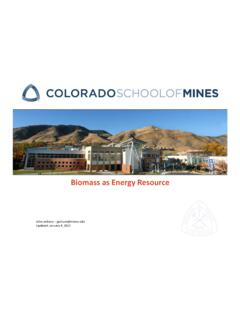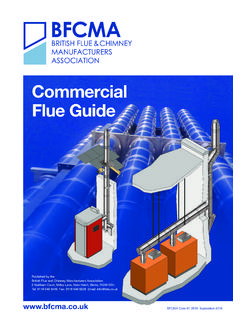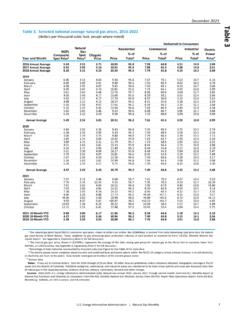Transcription of Natural Steam Methane Reforming (SMR) - Campus Tour
1 John Jechura January 4, 2015 Hydrogen from Natural Gas via Steam Methane Reforming (SMR)Energy efficiency of hydrogen from Natural gas Definition of energy efficiency From basic stoichiometry CH4+ 2 H2O CO2+ 4 H2 fuel to satisfy the heat requirements From real processes SMR Steam Methane Reforming Water shift reactions Heat integration CO2removal or PSA?2 Energy Efficiency outiniEE Usable energy out of a process compared to all energy inputs Energy values could be heat, work, or chemical potential (heating value) HHV (Gross): fuel + O2 CO2+ H2O (liquid) LHV (Net): fuel + O2 CO2+ H2O (vapor) Energy values may have to be discounted when combining different types Should the HHV be discounted when combining with heat values?HHVLHVBtu/scf Btu/scf Btu/scf Data BookHHVLHVD erived from Aspen Plus Stoichiometery CH4+ 2 H2O CO2+ 4 H224 HCHmol4molNN Production: Apparent efficiency (HHV basis) Just from stoichiometry: Include heat of reaction:4 METHANEWATERH2-CO2Q-RXNQMAKE-H24 How do we provide the heat of reaction?
2 MolNN Could use additional Methane mol fuel /mol reactant (HHV basis) Production: Efficiency including fuel (HHV basis) METHANEWATERH2-CO2Q-RXNFUELAIRFLUE-GASMA KE-H2 BURNER5 Steam Methane Reforming & Water Gas ShiftSteamNatural GasReforming ReactorHigh Temperature Shift ReactorLow Temperature Shift ReactorHydrogen PurificationFuel GasFlue GasHydrogenMethanation ReactorCO2 Reforming . Endothermic catalytic reaction, typically 20 30 atm & 800 880 C (1470 1615 F) + H2O CO + 3 H2 Shift conversion. Exothermic fixed bed catalytic reaction, possibly in two steps. CO + H2O CO2+ H2 HTS: 345 370 C (650 700 F)LTS: 230 C (450 F) Gas Purification. Absorb CO2(amine) or separate into pure H2stream (PSA or membrane). Methanation. Convert residual CO & CO2 back to Methane . Exothermic fixed bed catalytic reactions at 370 425 C (700 800 F).
3 CO + 3 H2 CH4+ H2 OCO2+ 4 H2 CH4+ 2 H2O6 SMR Alternate Designs Traditional with 2 stages shift reactors 95% to 98% purity Newer designs with PSA (Pressure Swing Adsorption) lower capital costs, lower conversion, but very high purity (99%+) 7 Process ConsiderationsKaes [2000]Molburg & Doctor [2003]Nexant Report [2006]OtherModel as conversion reactorModel as equilibrium compounds converted to H2S & adsorbed in ZnO temperature increase500 - 800 F depending on technology. 700 F most up to 725 psi (50 bar)Reformer1450 - 1650 F exit1500 F20 - 30 atm (295 - 440 psia)Equilibirium Gibbs reactor with 20 F approach (for design).Model as equilibrium F (455-540 C) inlet1470-1615 F (800-880 C) outlet650 - 700 F entrance for HTS + LTS660 F entrance940 F (504 C) inlet500 - 535 F entrance when no LTSE quilibirium Gibbs reactorFixed 90% CO conversionAll components inert except CO, H2O, CO2, & - 450 F entrance400 F entranceEquilibirium Gibbs reactor480-525 F (249-274 C) outletAll components inert except CO, H2O, CO2, & 90% CO conversionMethanation500 - 550 F entranceEquilibirium Gibbs reactorAll components inert except CH4, CO, H2O, CO2, & Purification Model as component splitterModel as component splitterMDEA circulation, duty, & work estimates from GPSA Data BookTreated gas 10 - 15 F increase, 5 - 10 psi decrease, water saturatedTreated gas 100 F & 230 psi (16 bar)
4 ExitRejected CO2 atmospheric pressure & water saturated95% CO2 recoveryPSAM odel as component splitterModel as component splitter100 F entrance90% H2 recovered75 - 85% recovery for "reasonable" capital costs (higher requires more beds)H2 purity as high as contains product stream as contaminant200 - 400 psig feed pressure for refinery applications4:1 minimum feed:purge gas ratio. Purge gas typically 2 - 5 ReactorsHigh Temperature Shift ReactorLow Temperature Shift Reactor8 HIERARCHYAMINEHIERARCHYHVAL-1 HIERARCHYHVAL-2381CO23315151 FEEDPRODUCT381427328Q81519151 WATER1628WQ231283772834918Q4271820417213 16Q3815QW26014Q-HEAT1Q33514 HOTPRODQREFORMERWATPUMPSTEAMGENHTSLTSCON D1 GASCOMPMETHANTRB asic SMR ProcessTemperature (C)Pressure (atm)Remember, direction of arrow indicates whether AspenPlus has calculated, NOT whether it is heat in/out 9 SMR Basic Process Energy RequirementsHIERARCHYHVAL-1 HIERARCHYHVAL-2 FEEDPRODUCTQWATERWQQQQCO2 WREFORMERWATPUMPSTEAMGENHTSLTSCOND1 GASCOMPHIERARCHYAMINEMETHANTRTREATEDTREA TED2 HOTPRODQQE nergy InputsEnergy Removalkcal/hrkWkcal/hrSteam Boiler3,742,371 Post Reformer Cooler2,238,933 Reformer6,332,965 Post HTS Cooler1,026,525 Amine Duty5,680,514 Post LTS Cooler2,305,814 Methanator Reheat553,190 Amine Coolers3,550,321 Sub-total16,309,040 Product Cooler800,533 Total9,922,126 BFW Pump10, Compressor385, Power125, ,246 Total16,831,286 Heating Values (HHV)kcal/hrkmol/hrkcal/molNatural Gas In21,363, Out25,938, H2 Purity.
5 89%H2 Product25,938,163 Total Inputs38,194,356 Efficiency68%10 HIERARCHYHVAL-1 HIERARCHYHVAL-2 FEEDPRODUCTQWATERWQQQQCO2 WREFORMERWATPUMPSTEAMGENHTSLTSCOND1 GASCOMPHIERARCHYAMINEMETHANTRTREATEDTREA TED2 HOTPRODQQSMR Heat Recovery for Steam GenerationEnergy InputsEnergy Removalkcal/hrkWkcal/hrSteam Boiler3,742,371 Post Reformer Cooler2,238,933 Methanator Reheat553,190 Post HTS Cooler1,026,525 Heat Sub-total4,295,561 Post LTS Cooler2,305,814 Sub-total5,571,272 Reformer6,332,965 Amine Duty5,680,514 Amine Coolers3,550,321 Sub-total16,309,040 Product Cooler800,533 Total9,922,126 BFW Pump10, Compressor385, Power125, ,246 Total16,831,286 Heating Values (HHV)kcal/hrkmol/hrkcal/molNatural Gas In21,363, Out25,938, H2 Purity:89%H2 Product25,938,163 Net Inputs33,898,795 Efficiency77%11 Reformer Furnace Design Hydrogen Production by Steam Reforming Ray Elshout, Chemical Engineering, May 201012 HIERARCHYD irect Fired Heaters for Reformer & Amine UnitEnergy InputsEnergy Removalkcal/hrkWkcal/hrSteam Boiler3,742,371 Post Reformer Cooler2,238,933 Methanator Reheat553,190 Post HTS Cooler1,026,525 Heat Sub-total4,295,561 Post LTS Cooler2,305,814 Reformer Flue Gas 648,651 Reformer6,332,965 Sub-total6,219,923 Amine Duty5,680,514 Sub-total16,309,040 Amine Coolers3,550,321 Product Cooler800,533 BFW Pump10, ,570,777 Gas Compressor385, Power125, ,246 Total16,831,286 Heating Values (HHV)kcal/hrkmol/hrkcal/mol EfficiencyNatural Gas In21,363, fuel Gas8,184, Unit fuel Gas6,659, ,206, Out25,938, H2 Purity.
6 89%H2 Product25,938,163 Net Inputs36,728,805 Efficiency71%13 HIERARCHYPre Heat the Reformer Feed?Energy InputsEnergy Removalkcal/hrkWkcal/hrSteam Boiler3,742,371 Post Reformer Cooler2,238,933 Methanator Reheat553,190 For Feed Preheat-1,200,000 Heat Sub-total4,295,561 Post HTS Cooler1,026,525 Post LTS Cooler2,305,814 Reformer5,132,965 Reformer Flue Gas 1,673,228 Feed Preheat1,200,000 Sub-total6,044,500 Amine Duty5,680,514 Sub-total16,309,040 Amine Coolers3,550,321 Product Cooler800,533 BFW Pump10, ,395,354 Gas Compressor385, Power125, ,246 Total16,831,286 Heating Values (HHV)kcal/hrkmol/hrkcal/mol EfficiencyNatural Gas In21,363, fuel Gas7,978, Unit fuel Gas6,659, ,000, Out25,938, H2 Purity:89%H2 Product25,938,163 Net Inputs36,523,078 Efficiency71%14 SMR Alternate Designs Traditional with 2 stages shift reactors 95% to 98% purity Newer designs with PSA (Pressure Swing Adsorption) lower capital costs, lower conversion, but very high purity (99%+) 15 Alternate Hydrogen Purification Processes Hydrogen Production by Steam Reforming Ray Elshout, Chemical Engineering, May 201016 WQQQQWQQSEPUse of PSA for Product PurificationEnergy InputsEnergy Removalkcal/hrkWkcal/hrSteam Boiler3,742,371 Post Reformer Cooler2,238,933 Feed Preheat1,200,000 For Feed Pre-Heat-1,200,000 Reformer5,132,965 Post HTS Cooler1,026,525 Sub-total10,075,336 Post LTS Cooler1,776,046 Reformer Flue Gas 1,674,739 BFW Pump10, ,516,243 Gas Compressor385, ,529 Total10,471,865 Heating Values (HHV)
7 Kcal/hrkmol/hrkcal/mol EfficiencyNatural Gas In21,363, fuel Gas7,984, ,347, Gas Out8,075, Out18,074, H2 Purity:100%H2 Product18,074,861 Total Inputs29,743,834 Efficiency61%17 HIERARCHYWQQQQWQQSEPUse of PSA for Product PurificationEnergy InputsEnergy Removalkcal/hrkWkcal/hrSteam Boiler3,742,371 Post Reformer Cooler2,238,933 Feed Preheat1,200,000 For Feed Pre-Heat-1,200,000 Reformer5,132,965 Post HTS Cooler1,026,525 Sub-total10,075,336 Post LTS Cooler1,776,046 Reformer Flue Gas 2,250,289 BFW Pump10, ,091,793 Gas Compressor385, ,529 Total10,471,865 Heating Values (HHV)kcal/hrkmol/hrkcal/mol EfficiencyNatural Gas In21,363, fuel Gas951, ,314, Gas Out8,075, ,389,739 Product Out18,074, H2 Purity:100%H2 Product18,074,861 Total Inputs22,711,111 Efficiency80%18 Integrated Process Hydrogen Production by Steam Reforming Ray Elshout, Chemical Engineering, May 201019 What should be the price of hydrogen?
8 Hydrogen sales should cover all costs plus profit Raw material costs (primarily Natural gas) Electricity Other operating expenses (staff, ..) Recovery of capital invested Minimum is to cover cost of Natural gas & power Example Natural gas $ per million BTU (as of March 30, 2011) = $ per kmol CH4 Electricity /kW hr (for 2010 per EIA for Industrial customers) PSA production scenario kmol/hr CH4 $385 per hr kW $31 per hr 263 kmol/hr H2 $ per kg Electrolysis comparison 80% electrolysis efficiency & 90% compression efficiency $ per kg o$ per kg with capital costs includedA Realistic Look at Hydrogen Price Projections, F. David DotyMar. 11, 2004 (updated Sept 21, 2004)20 Other References Refinery Process Modeling, L. KaesKaes Enterprises, Inc., 2000 Hydrogen from Steam Methane Reforming with CO2 Capture John C.
9 Molburg & Richard D. DoctorPaper for 20thAnnual International Pittsburgh Coal Conference, September 15 19, 2003 Equipment Design and Cost Estimation for Small Modular Biomass Systems, Synthesis Gas Cleanup, and Oxygen Separation Equipment; Task 1: Cost Estimates of Small Modular SystemsNREL Subcontract Report, work performed by Nexant Inc., San Francisco, CAMay 2006
